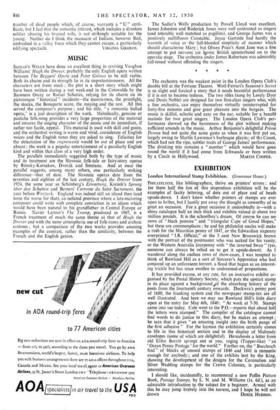EXHIBITION
London International Stamp Exhibition. (Grosvenor House.) PHILATELISTS, like bibliographers, thrive on printers' errors ; and for them half the fun of this stupendous exhibition will be the examples of faulty lettering, of dots out of place and of heads upside-down. I don't know whether printers of stamps are ever open to bribes, but I hastily put away the thought as unworthy of so great an occasion. For a great occasion it undoubtedly is—with a shiny catalogue half an inch thick and exhibits valued at about two million pounds. It is the schoolboy's dream. Of course he can see rows of " black pennies " and " triangular Cape of Good Hopes," but these are commonplaces ; he and his philatelist uncles will make a rush for the Mauritius penny of 1847, or the Edwardian sixpenny overprinted " I.R. Official," or the 5 cent New Brunswick brown with the portrait of the postmaster who was sacked for his vanity, or the Western Australia fourpenny with " the inverted Swan " (yes, someone can always be relied on to get it upside-down). As I wandered along the endless rows of show-cases, I was tempted to think of Rowland Hill as a sort of Sorcerer's Apprentice who had conjured up an unforeseen torrent, a flood that began as an interest- ing trickle but has since swollen to undreamed-of proportions.
It has provided excuse, at any rate, for an instructive exhibit or- ganised by the Postal History Society, which puts the upstart stamp in its place against a background,of the absorbing history of the posts from the fourteenth century onwards. Dockwra's penny post of 1680, the franking system and the newspaper stamp-tax are all well illustrated. And here we may see Rowland Hill's little diary open at the entry for May 6th, 1840: " At work at 7-50. Stamps came into use today. Cole went to the P.O.—reports that about half the letters were stamped." The compiler of the catalogue cannot find words to do justice to this diary, but he makes an attempt ; he says that it gives " an amazing insight into the birth pangs of the first adhesive." For the layman the exhibition certainly comes to life in this historical section and in the display of Mulready envelopes (some of which are delightful). Hereabouts a letter from old Elihu Burritt springs out at you, urging (Tupper-like) " an ' Ocean Penny Postage ' for the world." Further on, the " Buccleuch find " of blocks of unused stamps of 1840 and 1841 is romantic enough for anybody-;. and one of the exhibits lent by the King, showing the development of the designs for the Coronation and Silver Wedding stamps for the Crown Colonies, is particularly interesting.
I should like, incidentally, to recommend a new Puffin Picture Book, Postage Stamps, by L. N. and M. Williams (1s. 6d.), as an admirable introduction to the subject for a beginner. Armed with this he may jump bravely into the torrent, and I hope he will not






































 Previous page
Previous page